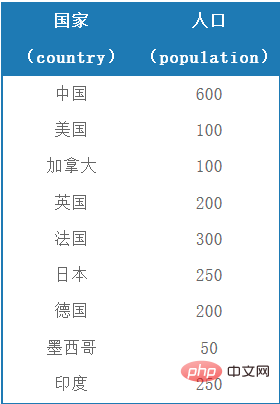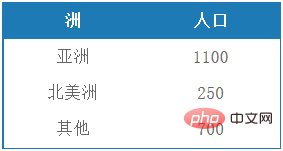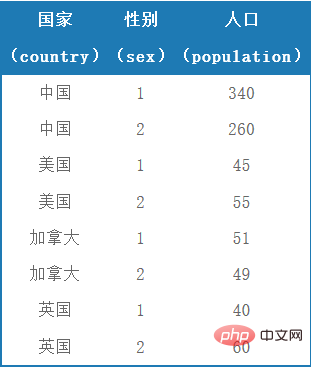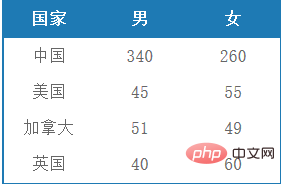在SQL中,“Case When”语句用于选择判断,在执行时先对条件进行判断,然后根据判断结果做出相应的操作;语法“CASE 字段 WHEN 条件1 THEN 操作1 WHEN 条件2 THEN 操作2...ELSE 操作n END;”。

本教程操作环境:windows7系统、Microsoft SQL Server 2016版、Dell G3电脑。
SQL中case when的用法
case when类似于编程语言中的if else判断、switch case语句。该语句执行时先对条件进行判断,然后根据判断结果做出相应的操作。
Case具有两种格式:简单Case函数和Case搜索函数。
简单Case函数:
CASE sex WHEN ‘1’ THEN ‘男’ WHEN ‘0’ THEN ‘女’ ELSE ‘其他’ END
Case搜索函数:
CASE WHEN sex = ‘1’ THEN ‘男’ WHEN sex = ‘0’ THEN ‘女’ ELSE ‘其他’ END
显然,简单Case函数胜在简洁,但是它只适用于这种单字段的单值比较,而Case搜索函数的优点在于适用于所有比较的情况。
还有一个需要注意的问题,Case函数在满足了某个符合条件后,剩下的条件将会被自动忽略,因此,即使满足多个条件,执行过程中也只认第一个条件。
(PHP中文网,有大量免费的SQL教程,欢迎大家学习!)
在使用 CASE WHEN时,可以把它当作一个逻辑上的匿名字段,字段值根据条件确认,在需要使用字段名时可以是用 as来定义别名。这么说还很抽象,看看下面 CASE WHEN的使用案例就清楚了。
使用场景
1、可以将已知数据按照某种方式进行分组,分析。

根据这个国家人口数据,统计亚洲和北美洲的人口数量。使用如下 SQL:
SELECT CASE country WHEN '中国' THEN '亚洲' WHEN '印度' THEN '亚洲' WHEN '日本' THEN '亚洲' WHEN '美国' THEN '北美洲' WHEN '加拿大' THEN '北美洲' WHEN '墨西哥' THEN '北美洲' ELSE '其他' END as '洲' , SUM(population) as '人口' FROM test GROUP BY CASE country WHEN '中国' THEN '亚洲' WHEN '印度' THEN '亚洲' WHEN '日本' THEN '亚洲' WHEN '美国' THEN '北美洲' WHEN '加拿大' THEN '北美洲' WHEN '墨西哥' THEN '北美洲' ELSE '其他' END;

这里的两个CASE WHEN都相当于一个字段,不过值得一提的是,第二个CASE WHEN 的THEN值并不用写明是什么洲,它只是用于将记录进行分组,所以THEN后面的值只有能区分这三种记录就行,GROUP BY也可以写成:
GROUP BY CASE country WHEN '中国' THEN 0 WHEN '印度' THEN 0 WHEN '日本' THEN 0 WHEN '美国' THEN 1 WHEN '加拿大' THEN 1 WHEN '墨西哥' THEN 1 ELSE 2 END;
2、用一个SQL语句完成不同条件的分组。
有如下数据:

用Case函数来完成按照国家和性别进行分组。使用如下SQL:
SELECT country, SUM( CASE WHEN sex = '1' THEN population ELSE 0 END ), --男性人口 SUM( CASE WHEN sex = '2' THEN population ELSE 0 END ) --女性人口 FROM Table_A GROUP BY country;
得到如下结果:

就第一个CASE WHEN讲解:
CASE WHEN sex = '1' THEN population ELSE 0 END
当记录的sex为1时,这个字段的值为记录的population值,否则为0,因此能计算出一个国家的男性人口。
更多SQL等编程入门教程,请持续关注PHP中文网!!
以上就是SQL中Case When的用法的详细内容,更多请关注php中文网其它相关文章!

每个人都需要一台速度更快、更稳定的 PC。随着时间的推移,垃圾文件、旧注册表数据和不必要的后台进程会占用资源并降低性能。幸运的是,许多工具可以让 Windows 保持平稳运行。




Copyright 2014-2025 //m.sbmmt.com/ All Rights Reserved | php.cn | 湘ICP备2023035733号